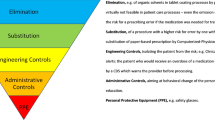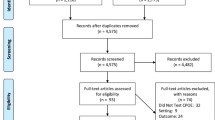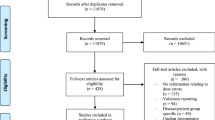Abstract
Despite large hospital costs for implementation and maintenance of Computerized Physician Order Entry (CPOE) for medication safety, little evidence exists to determine if predicted efficiency improvements translate into lower hospital resource utilization for inpatient pediatrics. The purpose of this study is to investigate the relationship between hospital CPOE use and resource utilization per case within children’s healthcare. The authors use a retrospective cross-sectional design with linear regression to assess relationships between hospital CPOE use and resource utilization per case. Despite large CPOE costs and financial barriers to adoption, we find that compared to those without CPOE, hospitals with CPOE did not have significantly lower cost per case. Because of the lack of evidence for financial benefit for CPOE use hospitals will likely need other motives to adopt CPOE. This emphasizes the importance of financial incentives for adoption of CPOE within children’s healthcare and represents important benchmark data for future comparison.

Similar content being viewed by others
References
Institute of Medicine (U.S.), Committee on quality of health care in America. Crossing the quality chasm: A new health system for the 21st century. National Academy, Washington, 2001.
Jha, A. K., Meaningful use of electronic health records: The road ahead. JAMA 304(15):1709–1710, 2010.
Teufel, R. J., 2nd, Kazley, A. S., and Basco, W. T., Jr., Early adopters of computerized physician order entry in hospitals that care for children: A picture of US health care shortly after the Institute of Medicine reports on quality. Clin Pediatr (Phila) 48(4):389–396, 2009.
Menachemi, N., Brooks, R. G., Schwalenstocker, E., and Simpson, L., Use of health information technology by children’s hospitals in the United States. Pediatrics 123(Suppl 2):S80–S84, 2009.
Ash, J. S., Gorman, P. N., Seshadri, V., and Hersh, W. R., Computerized physician order entry in U.S. hospitals: Results of a 2002 survey. J. Am. Med. Inform. Assoc. 11(2):95–99, 2004.
Jha, A. K., DesRoches, C. M., Campbell, E. G., Donelan, K., Rao, S. R., Ferris, T. G., et al., Use of electronic health records in U.S. hospitals. N. Engl. J. Med. 360(16):1628–1638, 2009.
King, W. J., Paice, N., Rangrej, J., Forestell, G. J., and Swartz, R., The effect of computerized physician order entry on medication errors and adverse drug events in pediatric inpatients. Pediatrics 112(3 Pt 1):506–509, 2003.
Holdsworth, M. T., Fichtl, R. E., Raisch, D. W., Hewryk, A., Behta, M., Mendez-Rico, E., et al., Impact of computerized prescriber order entry on the incidence of adverse drug events in pediatric inpatients. Pediatrics 120(5):1058–1066, 2007.
van Rosse, F., Maat, B., Rademaker, C. M., van Vught, A. J., Egberts, A. C., and Bollen, C. W., The effect of computerized physician order entry on medication prescription errors and clinical outcome in pediatric and intensive care: A systematic review. Pediatrics 123(4):1184–1190, 2009.
Yu, F. B., Menachemi, N., Berner, E. S., Allison, J. J., Weissman, N. W., and Houston, T. K., Full implementation of computerized physician order entry and medication-related quality outcomes: A study of 3364 hospitals. Am. J. Med. Qual. 24(4):278–286, 2009.
Committee on Drugs. American Academy of Pediatrics. Uses of drugs not described in the package insert (off-label uses). Pediatrics 110(1 Pt 1):181–3, 2002
Han, Y. Y., Carcillo, J. A., Venkataraman, S. T., Clark, R. S., Watson, R. S., Nguyen, T. C., et al., Unexpected increased mortality after implementation of a commercially sold computerized physician order entry system. Pediatrics 116(6):1506–1512, 2005.
Del Beccaro, M. A., Jeffries, H. E., Eisenberg, M. A., and Harry, E. D., Computerized provider order entry implementation: No association with increased mortality rates in an intensive care unit. Pediatrics 118(1):290–295, 2006.
Ash, J. S., Sittig, D. F., Dykstra, R., Campbell, E., and Guappone, K., The unintended consequences of computerized provider order entry: Findings from a mixed methods exploration. Int. J. Med. Inform. 78(Suppl 1):S69–S76, 2009.
Brailer, D. J., Health information technology is a vehicle, not a destination: A conversation with David J. Brailer. Interview by Arnold Milstein. Health Aff (Millwood) 26(2):w236–w241, 2007.
Kaushal, R., Jha, A. K., Franz, C., Glaser, J., Shetty, K. D., Jaggi, T., et al., Return on investment for a computerized physician order entry system. J. Am. Med. Inform. Assoc. 13(3):261–266, 2006.
Hillestad, R., Bigelow, J., Bower, A., Girosi, F., Meili, R., Scoville, R., et al., Can electronic medical record systems transform health care? Potential health benefits, savings, and costs. Health Aff (Millwood) 24(5):1103–1117, 2005.
Tierney, W. M., Miller, M. E., Overhage, J. M., and McDonald, C. J., Physician inpatient order writing on microcomputer workstations. Effects on resource utilization. JAMA 269(3):379–383, 1993.
Amarasingham, R., Plantinga, L., Diener-West, M., Gaskin, D. J., and Powe, N. R., Clinical information technologies and inpatient outcomes: A multiple hospital study. Arch. Intern. Med. 169(2):108–114, 2009.
Cutler, D. M., Feldman, N. E., and Horwitz, J. R., U.S. adoption of computerized physician order entry systems. Health Aff (Millwood) 24(6):1654–1663, 2005.
Poon, E. G., Blumenthal, D., Jaggi, T., Honour, M. M., Bates, D. W., and Kaushal, R., Overcoming the barriers to the implementing computerized physician order entry systems in US hospitals: Perspectives from senior management. AMIA Annu Symp Proc.: 975, 2003
McGlynn E., Identifying, categorizing, and evaluating health care efficiency measures. Final report (prepared by the Southern California Evidence-based Practice Center—RAND Corporation, under Contract No. 282-00-0005-21). AHRQ Publication No. 08–0030. Rockville, MD: Agency for Healthcare Research and Quality. April 2008
AHRQ., HCUP Kids’ inpatient database (KID). Healthcare cost and utlization project (HCUP). 2003. Agency for Healthcare Research and Quality, Rockville, MD. www.hcup-us.ahrq.gov/kidoverview.jsp
Sheldon I Dorenfest and Associates. User guide and data dictionary final—December 2003 release: Sheldon I Dorenfest and Associates, 2003
Merenstein, D., Egleston, B., and Diener-West, M., Lengths of stay and costs associated with children’s hospitals. Pediatrics 115(4):839–844, 2005.
Medicare and medicaid EHR incentive program basics EHR incentive program: US Department of Health and Human Services: Centers for Medicare & Medicaid Services. Accessed March 21, 2011. www.cms.gov/EHRIncentivePrograms/35_Basics.asp
Srivastava, R., and Homer, C. J., Length of stay for common pediatric conditions: Teaching versus nonteaching hospitals. Pediatrics 112(2):278–281, 2003.
Potts, A. L., Barr, F. E., Gregory, D. F., Wright, L., and Patel, N. R., Computerized physician order entry and medication errors in a pediatric critical care unit. Pediatrics 113(1 Pt 1):59–63, 2004.
Yu, F., Salas, M., Kim, Y. I., and Menachemi, N., The relationship between computerized physician order entry and pediatric adverse drug events: A nested matched case-control study. Pharmacoepidemiol. Drug Saf. 18(8):751–755, 2009.
Bates, D. W., Spell, N., Cullen, D. J., Burdick, E., Laird, N., Petersen, L. A., et al., The costs of adverse drug events in hospitalized patients. Adverse Drug Events Prevention Study Group. JAMA 277(4):307–311, 1997.
Classen, D. C., Pestotnik, S. L., Evans, R. S., Lloyd, J. F., and Burke, J. P., Adverse drug events in hospitalized patients. Excess length of stay, extra costs, and attributable mortality. JAMA 277(4):301–306, 1997.
Kaushal, R., Bates, D. W., Landrigan, C., McKenna, K. J., Clapp, M. D., Federico, F., et al., Medication errors and adverse drug events in pediatric inpatients. JAMA 285(16):2114–2120, 2001.
Classen, D. C., Avery, A. J., and Bates, D. W., Evaluation and certification of computerized provider order entry systems. J. Am. Med. Inform. Assoc. 14(1):48–55, 2007.
Author information
Authors and Affiliations
Corresponding author
Rights and permissions
About this article
Cite this article
Teufel, R.J., Kazley, A.S. & Basco, W.T. Is Computerized Physician Order Entry Use Associated with a Decrease in Hospital Resource Utilization in Hospitals That Care for Children?. J Med Syst 36, 2411–2420 (2012). https://doi.org/10.1007/s10916-011-9708-z
Received:
Accepted:
Published:
Issue Date:
DOI: https://doi.org/10.1007/s10916-011-9708-z




